The release of new Power Supply Unit (PSU) ATX specifications namely ATX 3.0 and ATX 3.1 in a very short time has created a lot of confusion among PC gamers and users. Most PC users are in a dilemma about whether to buy an ATX 3.0 PSU or wait for the upcoming ATX 3.1 power supply units. The melting issue observed with the 12VHPWR connector in many cases, Intel released the ATX 3.1 specifications where some very important changes have been made to address this issue. The melting issue was reported by a significant number of customers mainly with high-end GeForce RTX 40 series graphics cards that include GeForce RTX 4090 and RTX 4080 from Nvidia.
12VHPWR and 12V-2×6 Connector
12VHPWR connector was introduced in PCIe CEM 5.0 specification with ATX 3.0 standard while 12V-2×6 Connector was introduced in PCIe CEM 5.1 the ATX 3.1 standard. Both these connectors come with 16-pin where 12 power pins are used for power delivery while 4 sense pins or sideband signal pins are used for communication between PSU and Graphics Card. The sideband signals are SENSE0, SENSE1, CARD_PWR_STABLE, and CARD_CBL_PRES#. SENSE0 and SENSE1 pins are required or mandatory while the other two are optional. These sideband signal sense pins are used for communication with the graphics card regarding power delivery requirements, power states, or power budgets. Both the 12VHPWR and 12V-2×6 connectors are rated for a maximum of 600W power and each power pin is rated for a maximum current capacity of 9.2A.
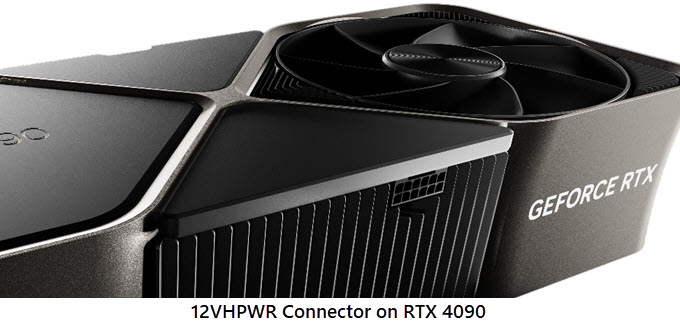
There has been a lot of confusion regarding the end side of the connectors and whether the changes are made to the female side of the connector or the male side. When we do not specify anything and talk about the 12VHPWR and 12V-2×6 connectors, it generally means the female side connector at the graphics card and PSU end. The graphics card and PSU side female connectors are also called 12VHPWR or 12V-2×6 headers soldered onto the PCB of the PSU or graphics card. The male end or cable side connector is called 12VHPWR or 12V-2×6 plug connector.
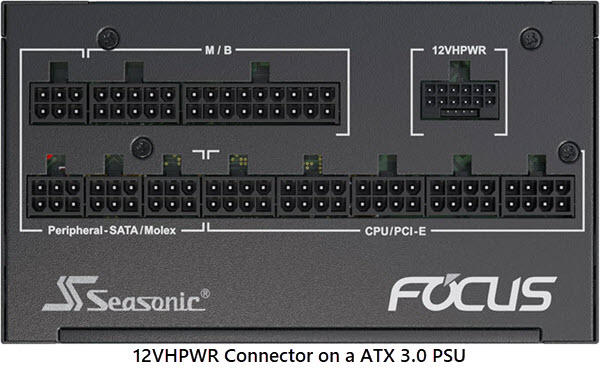
Important Note: 12VHPWR and 12V-2×6 power connectors are only required for PSUs greater than 450 Watts. These connectors are optional for PSUs less than 450W. The 12V-2×6 connector replaces the 12VHPWR connector to address melting and reliability concerns with the 12VHPWR connector. New power supply designs should mount only the 12V-2×6 connector and the 12VHPWR connector should be deprecated.
12VHPWR vs 12V-2×6 Connector Key Differences
One major difference between the 12VHPWR and 12V-2×6 Connector is that in the new 12V-2×6 connector, sense pins or sideband pins have been shortened and power pins have been lengthened. If the male 12V-2×6 connector is not inserted properly into the female 12V-2×6 connector on the Graphics Card or PSU side and if the sideband signal pins SENSE0/SENSE1 remain open then the power (0W) will not flow to the graphics card. This will prevent the melting of the 12V-2×6 Connector/Cable to avoid any kind of damage to the graphics card.
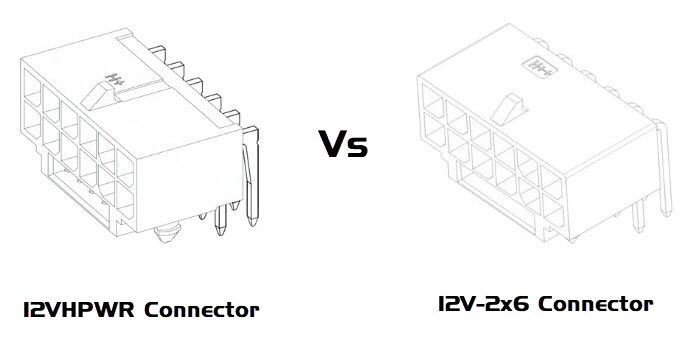
The 12VHPWR connector has a marking H+ on it while the 12V-2×6 connector is marked H++. These markings help users to identify the type of connector on the component as both these connectors look almost the same from the outside. The cable side of the connector (plug connector) remains almost unchanged at both the graphics card and PSU side. The wire thickness requirement for 12 power pins of the 12VHPWR and 12V-2×6 male connector cables is 16AWG while for 4 sense pins, it is 28AWG.

Labeling for 12VHPWR & 12V-2×6 Male Connectors on Cables

12V-2×6 Connector/Cable Compatibility
12V-2×6 Connector is backward compatible with ATX 3.0 power supplies having 12VHPWR connector and cables. It means if your graphics card has the new 12V-2×6 connector but your power supply has a 12VHPWR connector and cable then your graphics card should run fine without any issues. However, you won’t get the benefit of the safety mechanism present with ATX 3.1 power supplies through SENSE0/SENSE1 pins.
Power Excursions [PSU and GPU]
Power Excursion means the level of power spike or power surge a PSU can handle for a short amount of time. The total power excursion for both ATX 3.0 and ATX 3.1 power supplies specs is 200% or 2X. It means during power spikes or surges the PSU can support 2X or 200% of its total rated power for 100 μs or microseconds. The GPU power excursion in both specs is 3X or 300% which means the PSU can handle 3X or 300% of its rated power at the PCIe GPU connectors (12VHPWR / 12V-2×6) for 100 μs during graphics card power spike or surge.
ATX 3.0 PSU and GPU Power Excursion

ATX 3.1 PSU and GPU Power Excursion
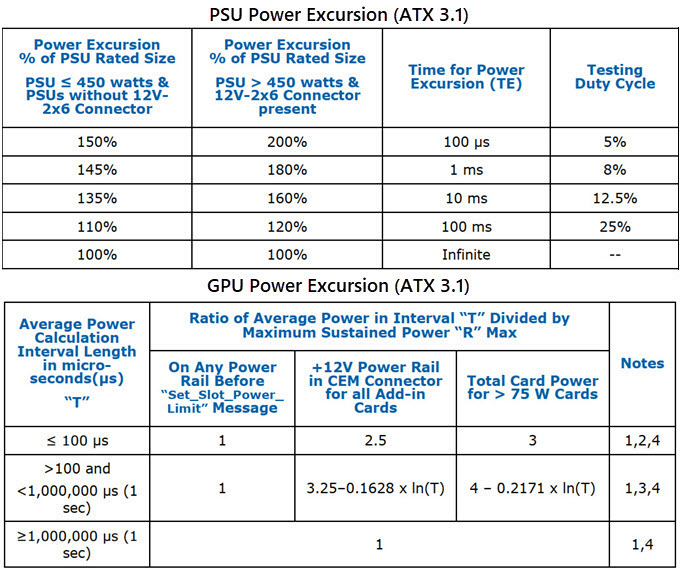
Note: For ATX 3.0 / ATX 3.1 power supplies having a capacity less than 450W, the total PSU power excursion is 150% or 1.5X its rated power.
ATX 3.0 vs ATX 3.1 PSU Major Differences for PCIe 5.0 Graphics Cards
| Key Parameters / PSU ATX Specifications Versions-> | ATX 3.0 PSU | ATX 3.1 PSU |
| 16-pin 12V Connector Name | 12VHPWR PCIe 5.0 connector | 12V-2×6 PCIe 5.1 connector |
| 16-pin 12V Connector Label | H+ | H++ |
| PCIe slot 12V Rail Current | 5.5A (Maximum) | 13.75A Peak for 0.1ms (165W) |
| PSU Power Excursion | 200% or 2X (for 100 μs) (for PSUs > 450W) | 200% or 2X (for 100 μs) (for PSUs > 450W) |
| GPU Power Excursion | 300% or 3X (for 100 μs) | 300% or 3X (for 100 μs) |
| Maximum Power Draw for Graphics Card | 600W (525W from 12VHPWR + 75W from PCIe Slot) | 675W (600W from 12V-2×6 + 75W from PCIe Slot) |
Should you get ATX 3.0 or ATX 3.1 PSU?
Well, it depends on your requirements, budget, and the graphics card you have. If you already have a high-quality and branded PSU having enough wattage then there is no need to buy an ATX 3.0/ATX 3.1 PSU even if you have a high-end graphics card with a 12VHPWR connector. However, if you have no budget issues and are running top of the line Nvidia 40 series graphics card such as RTX 4080 SUPER or RTX 4090 then it might be a good idea to get a good 850W or higher ATX 3.0 power supply.
When it comes to ATX 3.1 power supply units then there are very few models available right now and they are also a bit on the expensive side. Even if you get an ATX 3.1 PSU then also you won’t get the full benefits from it right now because the current high-end Nvidia GeForce 40 series graphics cards come with a 12HPWR connector. The 12V-2×6 connector will only be seen in the upcoming PCIe 5.0/PCIe 5.1 high-end graphics cards. It should be noted that the 12V-2×6 connector is backward compatible with PSUs with a 12HPWR connector which means even if you have an older PSU then it is not mandatory to upgrade to the ATX 3.1 PSU. In the future when the availability and pricing of ATX 3.1 power supplies become normal then only it makes some sense to invest in an ATX 3.1 PSU to future-proof your PC for the latest high-end PCIe 5.0 graphics cards with higher power requirements.
Queries?
If you have any doubts regarding the ATX 3.0 and ATX 3.1 power supplies concerning graphics cards then do let me know in the comment section below.
(*This post may contain affiliate links, which means I may receive a small commission if you choose to purchase through the links I provide (at no extra cost to you). Thank you for supporting the work I put into this site!)

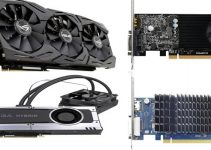

Are Add In Board, AIB, partners, like MSI, Gigabyte, and ASUS, using the H++ 12V-2×6 female connector on RTX 40 Series cards that are manufactured further from the launch date, when the RTX 40 Series was initially made?
No, they are not using it on the RTX 40 series cards.